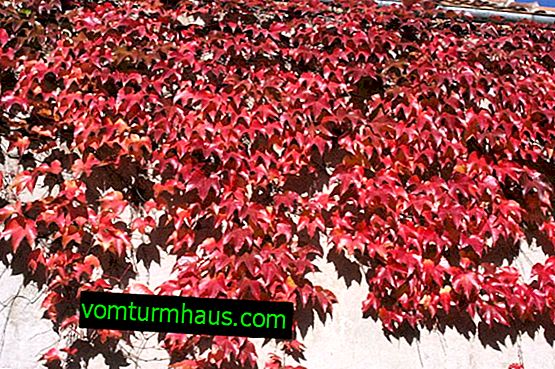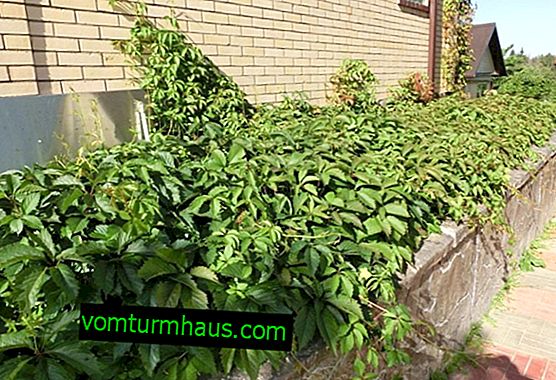Girl's grapes in autumn: planting, preparation for winter and care
Girl's grapes are used for decoration in landscaping. In order to get a strong plant by spring, it should be planted in the fall. Read more about the intricacies of planting this variety of weaving grapes and caring for it - later in the article.
Description and characteristics of girl's grapes
Woody plant of the grape family. Growing, it forms flexible, long shoots, which, thanks to the tenacious antennae, cover any vertical support. Depending on the variety, the liana grows from 3 m to 20 m in length.
“Virgin”, or “virgin ivy” (also called a plant), is rapidly developing and increasing its leaf mass. The annual growth of shoots is 2-3 m. Foliage of complex structure, 3- and 5-fingered, with serrated edges.
Foliage color may be:
- bright green;
- golden yellow;
- crimson red;
- brown.
Fruits in late September. The berries are small, dark blue or ink, contain a lot of acid, so they are considered inedible.
Popular varieties:
- Five-leaf ivy is a fast-growing vine, grows up to 18 m in height. The bark on young shoots of a red tint, as the bush grows older, it darkens. Finger leaves of 5 segments on a long thick petiole. Young records - bright green, closer to fall covered with scarlet.

- Tri-walled ivy - the length of an adult vine is 15 m, the leaf plate is divided into three parts. The top side of the sheet is glossy.

- Raspberry wine - develops up to 10 m in height. Leaf plates rounded at the base of the petiole are divided into three lobes. The surface is streaked with veins, the color of young foliage is green, in the fall it is painted in different colors - yellow, red-orange, dark burgundy.

Planting Girl's Grapes in Autumn
It is recommended to plant a decorative vine in September, before freezing begins. This will allow the vine to reliably take root before winter, and in spring, at a favorable temperature, the plant will grow faster.
Preparatory work
Check out

Virgin ivy is unpretentious to the composition of the soil and can grow on any land. The acidity of the soil can be neutral and slightly elevated (5–7 pH). But for the rapid growth and development of the vine, you still need to provide comfortable conditions.
At the place of future planting, the soil is dug up, mixing the upper layer with the lower layer. At the same time, the area is cleaned of plant debris. When digging, make a bucket of sand and compost, 300 g of superphosphate, 1 l of wood ash per 1 m².
Landing methods
In landscape design, a creeping vine is used to decorate arches, arbors, terraces. They plant the plant on open, unglazed balconies to create shade and coolness in the hot season. Under the bright and dense foliage, you can hide the defects of stone fences or walls of the house.
For decoration, girl’s grapes are planted in two ways:
- when decorating a vertical support - the distance between the pits is at least 1 m;

- for carpet flooring, the distance between the pits is 0.6 m.

Cuttings
Harvesting of planting material is carried out in spring or summer. You need to know how to properly cut the vine, so as not to have problems with rooting. Healthy shoots are cut up to 30 cm long with the presence of several elastic buds. The bark should be evenly colored, the cuttings are flexible. The shoots are placed in a container of water, which is regularly changed, until the formation of roots.
The technology of planting cuttings:
At the bottom of a hole of a suitable size (60 × 60 cm), 20 cm of a drainage layer (crushed stone, broken brick) is laid.
- Seedlings are pruned, leaving 4 eyes.
- Immediately put a peg in the hole for future support.
- A stalk placed in a pit is filled up, leaving 2 eyes above the surface of the soil, 2 eyes under it.
- The earth is tamped and watered abundantly.
Shoots
The culture can be propagated by side shoots. To do this, cut a branch up to 2 m long from the vine and drip it horizontally to a depth of no more than 3-4 cm. After that, water abundantly.
After 10-12 days, roots will appear. Dig out the shoot, clean it from the ground and cut into cuttings. Planting and rooting seedlings is possible according to the technology described above.

Seeds
The vine propagates by seed, but this process is long, so the method is used infrequently. Sowing is carried out in the spring (March) or in the winter (October). For the spring procedure, the seeds need to be stratified so as not to die in cold soil. To do this, 40–45 days before sowing, the seeds are placed in a container with wet sand and placed in a refrigerator on a vegetable shelf.
In the autumn procedure, the seeds are cleaned of the protective skin, soaked for a day in a slightly pink solution of potassium permanganate. Seeds are sown in furrows to a depth of 1.5 cm, the distance between seeds is 30 cm. Subsequently, dense crops can be planted. Sprouts after autumn sowing will appear next spring, spring sowing will rise in a month. Learn also how to propagate girl's grapes.
Care after landing
Girl's grape is an unpretentious culture, which an inexperienced gardener can also grow, providing minimal care.
Necessary conditions for growing
The vine will require special attention during the period of active growth. Young plants need trellis support with several levels of garter. Given the rapid growth and the number of shoots, it is advisable to use a special tool, tapener, for garter.

The device reduces the time of the procedure and does not damage the shoots. Mandatory are loosening to saturate the roots with oxygen and weeding from weeds.
Important! So that young stalks exposed at the surface of the earth do not overheat, they need to be regularly earthed up, raking up to 20 cm of earth.
How to feed and how to water?
With normal rainfall, the vine is watered 3-4 times per season. A 10-liter bucket of water is poured under the root of each bush. Fertilizing is carried out simultaneously with watering, a series of the Kemira mineral complex is suitable for this. For the first time in the spring, “Kemira Combi” is used, where the microelements necessary for growth and development are balanced.

Fertilizing is recommended in liquid solutions (40 g of substance per 40 l of water). The second dressing is carried out during the formation of flower ovaries with the drug "Kemira Lux" (20 g / 10 l). During fruiting, the plant needs potassium (20 g of potassium sulfate is dissolved in 10 l of water). In autumn, after harvesting, plants are sprayed on a leaf of kalimagnesia 15 g / 10 l.
Dates and trim features
The question is whether it is necessary to prune the vine, given the rate of development of green mass, becomes irrelevant. Without a procedure, the cultural planting of an ornamental plant will turn into thickets. Important! Cut the shoots 5 mm above the kidney so as not to leave sloppy stumps. Pruning is carried out annually, almost all year round:
- In the spring - before the sap flow begins, you need to remove branches that have not withstood frost, broken with signs of damage. Inspect the bush for shoots that do not want to grow in the direction of the support, they are also removed.
- In the summer - remove the newly formed stepsons, thickening the crown. Remove shoots, the tops of which changed the direction of growth.
- In autumn - prepare for shelter for the winter. Damaged, dried branches are removed.
Video: Autumn pruning of wild grapes
Transfer
If you want or need to transplant the overgrown bush to a new place, the procedure is carried out in late spring or summer. Dig the selected area onto the bayonet of the shovel, make compost (0.5 buckets per 1 m²).
You need to transplant according to this scheme:
- They dig a hole 60 × 60 cm, put on the bottom 15–20 cm of broken brick, sprinkle with a hill of soil.
- A bush is placed on the hill of the earth, spreading the roots so that they do not bend, sprinkle the plant with soil.
- The root neck of the bush should remain above the surface.
- After the bush abundantly watered.
Read also how to decorate your site with cypress milkweed.
Winter preparations
The open culture is recognized as a variety of five-leaf grapes. While the remaining varieties are recommended to be prepared for winter.
For this, the lash of the vine is removed from the support, placed in a trench, the bottom of which is covered with dry foliage. From above, the plant is also covered with foliage and covered with paws of needles or agrospan.
Pest and Disease Control
Culture is not susceptible to disease, but can be attacked by aphids. If the pest was noticed immediately, a soap solution with the addition of alcohol (1/3 of the solution volume) will help to cope with it. If an insect colony is found, you can use the drug Fitoverm. To spray the vines, the concentrated preparation is diluted in a proportion of 5 ml / 4 l of water. Re-treatment is carried out after 3 weeks.

A vine planted near the walls of farm buildings or a residential building can serve as an entrance for small rodents. Traps for mice and rats will help secure your property and food. The plant itself has a heavy-duty bark, which is unattractive to rodents.
Difficulties in growing vines can arise as a result of improper care:
- Dry leaves - lack of nutrition. Use balanced medications three times a season (at least).
- Leaves crumble, possibly rotting roots - excess moisture. Adjust the frequency and dose of watering. Make sure there are no near groundwater.
- Leaves lose varietal qualities: bright color and size - lack of light. A constant shadow does not allow the plant to express itself in all its glory. Light needs bright, diffused, partial shade is possible.
The charm of girl's grapes lies in their unpretentiousness and rapid growth. For several years, ivy can cover the walls of the house, arbor or terrace with a dense blanket, decorate the old fence. Designers love the vine for a beautiful neighborhood with other climbing, flowering plants. It is only necessary to provide the plant with proper and regular care.








